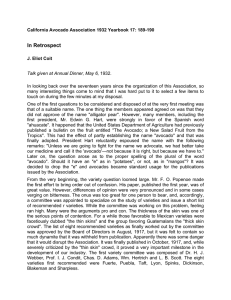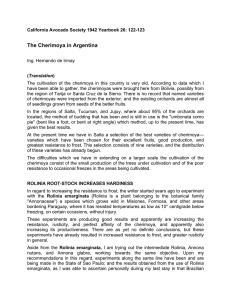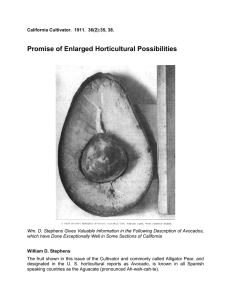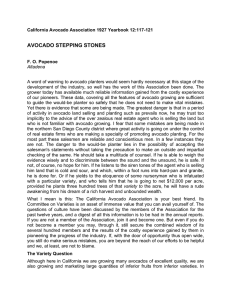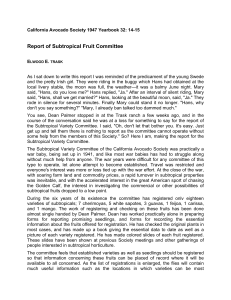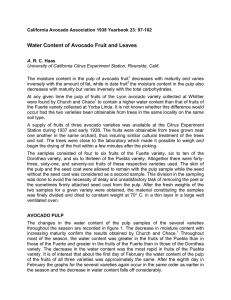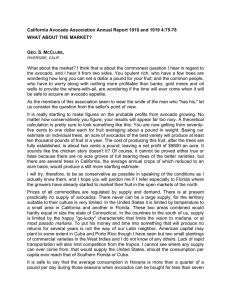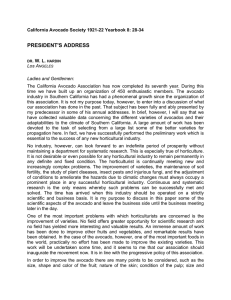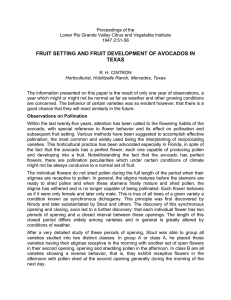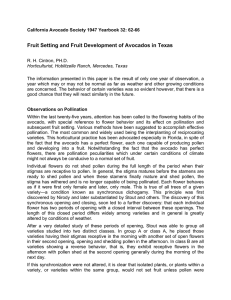HAS THE MEXICAN TYPE OF AVOCADO A PERMANENT PLACE IN
advertisement
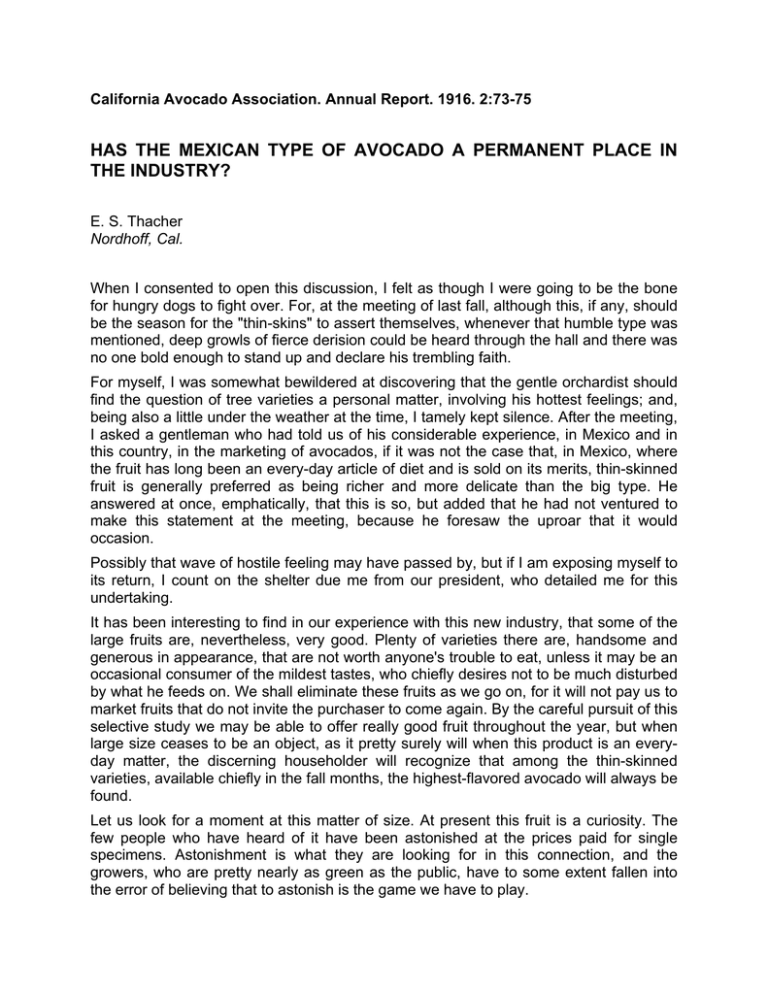
California Avocado Association. Annual Report. 1916. 2:73-75 HAS THE MEXICAN TYPE OF AVOCADO A PERMANENT PLACE IN THE INDUSTRY? E. S. Thacher Nordhoff, Cal. When I consented to open this discussion, I felt as though I were going to be the bone for hungry dogs to fight over. For, at the meeting of last fall, although this, if any, should be the season for the "thin-skins" to assert themselves, whenever that humble type was mentioned, deep growls of fierce derision could be heard through the hall and there was no one bold enough to stand up and declare his trembling faith. For myself, I was somewhat bewildered at discovering that the gentle orchardist should find the question of tree varieties a personal matter, involving his hottest feelings; and, being also a little under the weather at the time, I tamely kept silence. After the meeting, I asked a gentleman who had told us of his considerable experience, in Mexico and in this country, in the marketing of avocados, if it was not the case that, in Mexico, where the fruit has long been an every-day article of diet and is sold on its merits, thin-skinned fruit is generally preferred as being richer and more delicate than the big type. He answered at once, emphatically, that this is so, but added that he had not ventured to make this statement at the meeting, because he foresaw the uproar that it would occasion. Possibly that wave of hostile feeling may have passed by, but if I am exposing myself to its return, I count on the shelter due me from our president, who detailed me for this undertaking. It has been interesting to find in our experience with this new industry, that some of the large fruits are, nevertheless, very good. Plenty of varieties there are, handsome and generous in appearance, that are not worth anyone's trouble to eat, unless it may be an occasional consumer of the mildest tastes, who chiefly desires not to be much disturbed by what he feeds on. We shall eliminate these fruits as we go on, for it will not pay us to market fruits that do not invite the purchaser to come again. By the careful pursuit of this selective study we may be able to offer really good fruit throughout the year, but when large size ceases to be an object, as it pretty surely will when this product is an everyday matter, the discerning householder will recognize that among the thin-skinned varieties, available chiefly in the fall months, the highest-flavored avocado will always be found. Let us look for a moment at this matter of size. At present this fruit is a curiosity. The few people who have heard of it have been astonished at the prices paid for single specimens. Astonishment is what they are looking for in this connection, and the growers, who are pretty nearly as green as the public, have to some extent fallen into the error of believing that to astonish is the game we have to play. But the permanent market is not made by surprising people. It rests rather on the persistent supplying of things that are good and convenient, and when you have 100,000 people habitually buying avocados in Los Angeles, instead of a few dozen curious or lavish individuals, they will not generally be found looking for fruits that approximate the pumpkin in size, if not in flavor. What is a convenient size for the avocado? I should say that a fruit that furnishes as much as one man will ordinarily eat at a sitting is quite large enough. A 5-ounce fruit will do that with a reasonable ratio of flesh to seed, and it seems to me that the permanently favorite sizes are likely to run from 5 to 10 ounces, and that we shall soon be looking with commendation on those trees of the large type that can be induced to moderate the size of their fruits in favor of greater numbers. Numbers are a pretty good feature and I have sometimes found that the 3-ounce size, though taken less readily in the market than those from 6 to 8 or 9 ounces, brought more money by the box. Many of us, I presume, are or have been orange growers, and those who were here when that industry was beginning in California remember that the very large navels were often at a high premium. It was a new thing that California should be producing oranges, and actually making a commercial matter of it; and the bigger the orange, the more surprising and interesting it was. It was not long, however, that this surprise was marketable, and those who in this recent Valencia season have been fortunate enough to have great numbers of small oranges have had a lesson which may well be applied to the avocado. It has been the habit of our nurserymen to recommend the Mexican seedling for home consumption only, granting its excellent quality, but disclaiming fitness for commercial use. One reason for this is the size question, and it is true that if one grows seedlings there will be many trees whose fruit is too small for marketing satisfactorily. But trees budded from the varieties that have proved their quality are free from this objection. The other point is carrying quality, it having been generally believed that a thick skin is almost necessary for long shipments. My slight experience disputes this and a year ago we had Mr. Boschet's testimony that there seemed to be no difference between the two types in this respect. The skin of the Mexican type is always much tougher and thicker than that of the Bartlett pear, which California ships in such great quantity to distant markets, and on the other hand there seems to be plenty of room inside the shell of the palta for unhealthy conditions to produce disaster It is, of course, of great importance to find as fast as possible what thin-skin varieties produce fruit of good size, of the best quality and in dependable quantity; what sorts are hardiest as to frost (there is a great range in this respect); what sorts are handsome, inviting in appearance; what sorts are tenacious (some good varieties drop off very easily); and what are free from the habit of developing soft spots or other blemishes. To this end we should not be too urgent in our advice to plant only the established varieties. We are at the experimental stage and there should be a great deal of seedling observation. Perhaps the most interesting feature of the avocado is its immense individual variation, coupled with the fact that until this country took it up there had nowhere been any systematic breeding or fixing of varieties. When I was first inquiring about it, a friend obtained for me a letter from the Mexican minister of Fomento, in which he said, "There are no budded ahuacates in Mexico; in fact there are very few trees planted anywhere. They come up in corners." Nevertheless, Mexico, which is our chief source for both types, the so-called Guatemalan as well as the Mexican, has, in a wholly accidental way, produced all sorts of fruits, and our named varieties are simply selections from the product of their seeds. We mustn't begin just yet to be too wise on the subject, for we have hardly done more than look over the fence upon a field that has not been measured. We have thin-skins to cover the markets from August to November. We have thick-skins from March to July. There remain only December, January and February, and our nurserymen are reaching out to supply these months also, and have perhaps done so already, though it is not covering January and February to pick and market in those months fruit that is not really fit to eat until March. Our unbelieving friends have a patronizing way of conceding the fall market, saying that the thin skins, after all, have their use, as fillers of the gap. The difference between us is that, whereas they conceive that the industry is marking time, or soft-pedaling, through those months when the big fruit is in retirement, I maintain that it is only in that period that the true and supreme ahuacate is to be had and that the rest of the year is just doing what it can to keep the business alive. I have not undertaken to cover all the points in this case. I was simply to put the subject before you, and I have considered the probable scarcity of time as a reason for doing this with extreme brevity. We are all learners together, with a very new subject, and no inquiry can as yet be considered closed. I will only repeat my opinion that, so far as I can see at present, the true Mexican ahuacate, the leading type in the country which certainly has the lead in the use and knowledge of this fruit is well worthy of our serious development and promises a commercial reward to intelligent perseverance. However, the question of comparative merit may finally be settled between the two types, they are so different that neither should be discarded in favor of the other, any more than we should abandon the pear because we approve of the apple.
